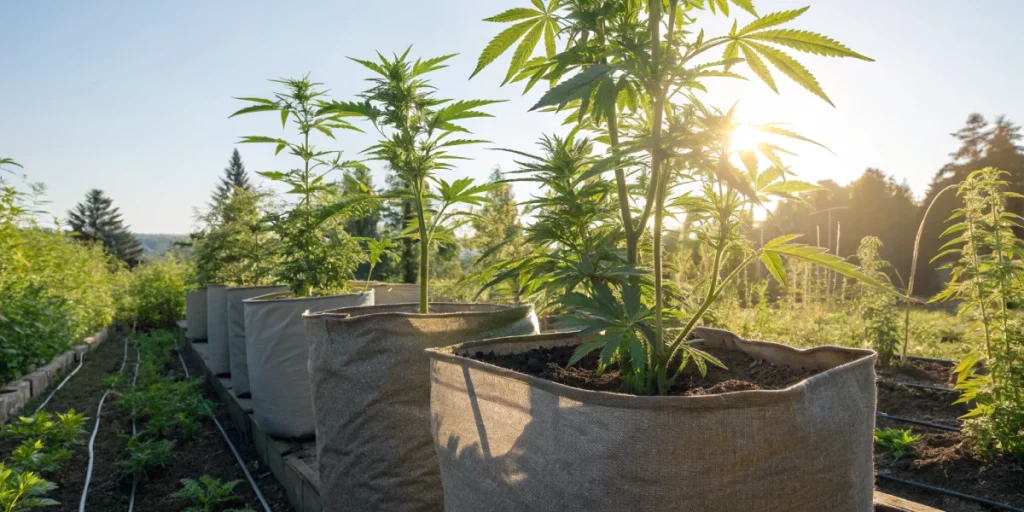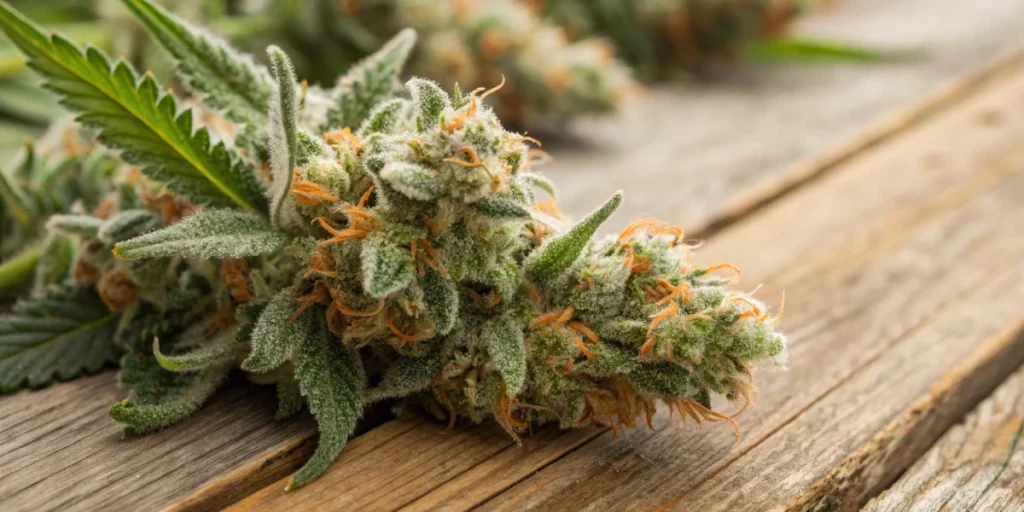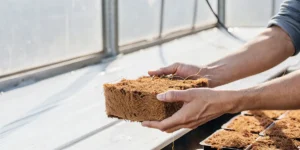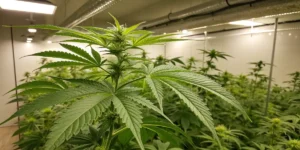Ever wondered what makes some strains finish faster without losing yield or quality? That’s exactly what growers find fascinating about the Honey Cream Fast strain. But what happens if you don’t hit the right timing or dial in the grow room conditions? Stick around, because these details might be the difference between average and amazing. You’ll want to read to the end, especially if fast harvests and flavorful buds matter to you.
Honey Cream Fast Strain: Exceptional Genetics and Effects
Origins and Genetics
Honey Cream Fast strain is the result of crossing BlueBlack, Maple Leaf Indica, and White Rhino. This trio of genetics delivers dense, resin-rich buds and a flowering time much shorter than most photoperiod strains. Breeders focused on creating a fast indica-dominant variety with sweet, creamy aromas and easy cultivation for all levels. Its genetic lineage also contributes to natural pest resistance and a compact, bushy structure that supports dense flower clusters.
It’s considered a fast version due to its photoperiod base shortened through selective breeding. This means growers can trigger flowering like any other photoperiod plant but finish harvesting earlier, typically in six to seven weeks. The genetic stability of Honey Cream Fast strain makes it consistent across different environments. That consistency helps growers plan ahead with confidence, especially in regions where the weather changes quickly.
Effects and Potency
The effects of Honey Cream Fast strain lean toward the deeply relaxing side. With THC levels averaging around 18% to 20%, users often report a strong body buzz and calming mental clarity. It’s ideal for late evenings or winding down after a busy day. Some also find it beneficial for easing mild discomfort or promoting restful sleep.
The aroma profile combines earthy, sweet vanilla notes with a creamy aftertaste. As the effects build, a gentle euphoria sets in, followed by a soothing heaviness in the limbs. This balance of taste and effect makes it popular among recreational and medicinal users alike. Whether used in a vaporizer or rolled into a joint, the flavor remains smooth and satisfying.
Environmental Requirements for Growing Honey Cream Fast Strain
Setting Up the Growing Cannabis Space
Start with a clean space and stable environment. Honey Cream Fast strain responds well to both soil and hydro setups. Whether you’re using a tent, closet, or small room, make sure you have proper air exchange. A carbon filter can help with the intense aroma during bloom. Adequate ventilation ensures a healthy oxygen exchange, which is essential for root development and nutrient absorption.
Use reflective materials on walls to improve light efficiency. Position oscillating fans to ensure even airflow around the canopy. Keep wires off the floor to reduce tripping hazards and make daily maintenance easier. Make space for drainage trays or automated runoff management. A tidy setup not only makes life easier but also prevents common issues like mildew and pest infestations.
Temperature and Humidity
Honey Cream Fast strain thrives between 21–26°C during the day and 18–20°C at night. In veg, maintain humidity around 60%, then drop it to 40–45% during flowering. Dehumidifiers and humidifiers help fine-tune the balance based on your grow stage. Stable levels help plants focus on growth instead of fighting stress.

Indoor Cannabis Cultivation
Advantages of Growing Indoors
Indoor setups allow full control over all the variables that matter: light, airflow, nutrients, and humidity. For Honey Cream Fast strain, that means maximizing its potential in a shorter time. The compact structure fits nicely into tents or closets, ideal for discreet cultivation. Indoor growers also benefit from year-round growing possibilities, especially in colder climates.
Another big advantage is consistency. Indoor growers can repeat successful grows using the same setup. Since Honey Cream Fast strain has a short flowering period, mistakes have less time to correct. Keeping your indoor environment steady helps you avoid problems that might cost yield. You’ll also find it easier to maintain privacy, reduce smell, and automate many tasks.
Lighting Needs
Use full-spectrum LEDs or high-quality HPS lights with at least 600W output. During veg, provide 18 hours of light. For flowering, switch to 12/12. Maintain 30–40 cm distance between the canopy and the light to prevent bleaching or burns. Consider using light movers or supplemental side lighting to reduce shadow spots and stimulate lower bud growth.
Outdoor Cannabis Cultivation
Best Conditions for Outdoor Growth
Honey Cream Fast strain adapts well to outdoor settings, especially in regions with short summers. Plant in nutrient-rich soil with good drainage. Choose a spot with at least six hours of direct sunlight each day and some wind protection. Raised beds or fabric pots help regulate temperature and prevent root-bound growth.
In most climates, you can plant in late spring and harvest by early September. Its fast flowering time helps avoid autumn rains and mold. Keep an eye out for pests and consider using organic sprays or companion planting to deter insects. Calendula, basil, and marigold are great natural repellents that work well alongside cannabis.
Advantages of Growing Honey Cream Fast Strain
One of the biggest reasons growers choose Honey Cream Fast strain is its speed. Most plants finish flowering in six weeks, cutting down your overall cycle time. This makes it possible to fit more harvests into the season. For commercial growers, that speed translates to higher profit potential. For hobbyists, it means fresher product more often.
It also requires minimal training. The plant stays short and stocky, making it easy to manage even in small spaces. Beginners can enjoy a smooth learning curve, while experienced growers will appreciate the high resin production and terpene-rich profile. Its predictable growth structure reduces surprises and helps streamline care routines.
Problems in Cultivating Honey Cream Fast Strain
Overwatering
Because of its compact root structure, Honey Cream Fast strain is sensitive to overwatering. Wait until the top 3 cm of the soil dries before the next watering. Overwatering causes root rot and nutrient lockout, both of which slow growth and hurt yields. Use fabric pots to improve aeration and reduce the risk of soggy roots.
Pest Infestations
Common cannabis pests like spider mites and aphids can affect Honey Cream Fast strain, especially outdoors. Use neem oil or insecticidal soaps weekly as a preventive measure. Indoors, proper airflow and clean surfaces keep most pests from settling in. Sticky traps and regular inspections can help detect issues early.
Similar Strains
Blue Sunset Sherbert
Blue Sunset Sherbert combines high THC potency with sweet berry and citrus flavors. Its quick flowering time and compact growth make it an excellent companion choice for fans of Honey Cream Fast strain who want fruity aromas and resin-heavy buds.
Lemon Tree
Lemon Tree is another short-flowering cultivar prized for its strong citrus aroma and dense colas. It thrives in both soil and hydro setups, offering a tangy alternative that pairs well with creamy strains in aroma and effect.
Critical Runtz
Critical Runtz features a sweet, fruity terpene profile and quick flowering traits. Its dense, colorful buds and high resin content appeal to extract lovers and growers aiming for fast returns with bold flavors.
Week-by-Week Growth Plan for Honey Cream Fast Strain
Week 1 – Germination and Seedling Stage
Start by placing Honey Cream Fast strain seeds in moist paper towels. Once taproots appear, transplant into small pots with a light soil mix. Keep temperature around 22°C and humidity near 70%. Use a humidity dome if needed. Provide gentle light and avoid overwatering. Keep light at 40 cm to avoid stretching while encouraging leaf formation.
Week 2 – Early Seedling Growth
Seedlings begin forming true leaves. Move to 18 hours of light. Maintain soil moisture and increase airflow. No nutrients are needed yet. Focus on temperature and stable humidity. By the end of the week, roots will anchor well, preparing for faster growth ahead. Leaves will grow broader, and stems will thicken slightly.
Week 3 – Continued Seedling Development
You’ll see stronger stems and leaf expansion. Gradually increase light intensity. Begin feeding a mild vegetative nutrient mix. Watch for early signs of nutrient needs or stress. Keep RH at 60% and temperatures around 24°C. Begin light fan movement to strengthen stalks. If using training techniques, wait until internodes are clearly defined.
Week 4 – Vegetative Growth Begins
Plant structure starts to form with new branches. Move into larger pots and apply light training like LST. Provide a balanced NPK feed at half strength. Increase airflow and monitor for pests. Maintain 18-hour light cycles and keep watering consistent but light. Consider topping if you’re aiming for bushier plants and multiple colas.
Week 5 – Accelerated Vegetative Growth
Stems thicken, and internodal spacing tightens. You can continue training or let the plant grow vertically. Switch to full-strength veg nutrients. Maintain steady environmental conditions. Prepare your setup for the flowering phase by checking timers and ventilation. This is the last week to shape your canopy before bloom begins.
Week 6 – Preparing for Flowering
Preflowers start forming. Transition to bloom nutrients with higher phosphorus. Change light schedule to 12/12 if not already done. Monitor pH closely and reduce RH to 45%. Remove any large fan leaves that block light penetration. You’ll notice a stretch phase where the plant gains height quickly.
Week 7 – Transition to Flowering
Bud formation becomes visible. Pistils appear and stretch slows. Maintain bloom feeding schedule. Avoid excessive pruning. Keep airflow strong and reduce nighttime temps slightly. Keep RH stable and inspect daily for signs of mold. Support branches with ties or netting if needed.
Week 8 – Early Flowering
Buds swell, and trichomes begin forming. Aroma intensifies. Support branches if necessary. Increase potassium slightly to aid flower density. Defoliate lightly to improve air movement. Stick to 12/12 lighting and monitor daily for issues. Begin looking for early signs of maturity in pistil color.
Week 9 – Mid-Flowering
Resin production ramps up. Trichomes go from clear to cloudy. Monitor nutrient needs and adjust as necessary. Use a magnifier to watch trichome development. This is a key window for aroma and flavor development. Flush lightly if salt buildup is suspected in soil.
Week 10 – Bud Development
Buds mature and pistils darken. Reduce nutrients gradually and flush with clean water. Keep temperatures stable to protect terpenes. Avoid any stress that might slow ripening. Smell should peak during this period. Watch for signs of foxtailing and adjust lights accordingly.
Week 11 – Late Flowering
Trichomes begin turning amber. Harvest window opens. Stop feeding and continue flushing. Keep RH low and airflow strong. Prepare drying area and cleaning tools. Avoid light exposure during dark periods. Wait for 20–30% amber trichomes for a balanced effect.
Week 12 – Harvesting Time
Cut branches and hang in a dark, ventilated room at 18–20°C and 50% RH. Dry for 7–10 days until stems snap. Then begin curing in airtight jars, burping daily for a week, then every other day. This stage shapes final flavor and smoothness. Curing for three to four weeks delivers the best aroma and potency.

FAQs about Honey Cream Fast Strain
What makes Honey Cream Fast strain flower so quickly?
It’s a photoperiod strain selectively bred for a shorter flowering cycle. Once it enters bloom, most phenotypes finish in six to seven weeks. This speed helps avoid early autumn weather and fits more harvests into the year. Fast flowering also reduces energy costs for indoor growers.
How much can I yield with Honey Cream Fast strain?
Indoors, expect around 450–500 grams per square meter with good light and care. Outdoors, each plant can yield 550–600 grams in ideal conditions. Proper feeding, airflow, and light intensity play a major role in reaching full potential. Training and pruning can boost overall yield.
Is Honey Cream Fast strain good for beginners?
Yes. Its compact size, quick flowering, and forgiving nature make it ideal for new growers. Just avoid overwatering and maintain a stable environment. It doesn’t require aggressive training, and its structure naturally supports healthy flower development. With minimal effort, beginners can enjoy impressive results.





